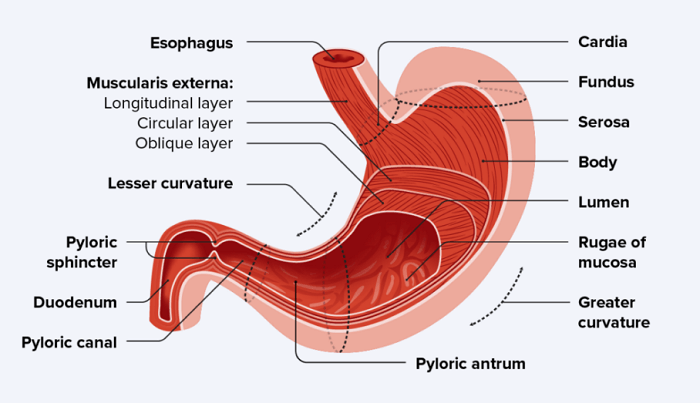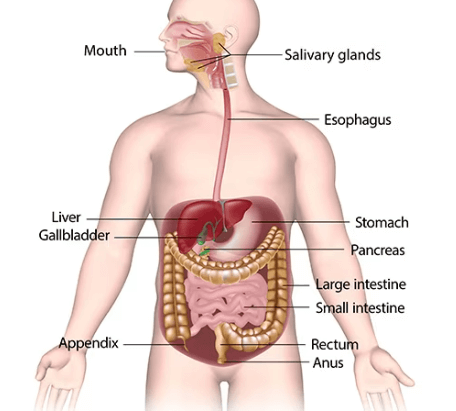Stomach DefinitionThe top left side of the abdominal cavity contains the muscular organ known as the stomach. Hydrochloric acid and digesting enzymes are secreted by several stomach cells. These chemicals help the body absorb nutrients by breaking down meals. 
Food enters the stomach through the esophagus. When food reaches the esophagus's end, it enters the stomach via a muscle valve known as the lower oesophagal sphincter. The stomach cells are constantly exposed to digestive juices and stomach contents. Cells produce a mucus coating to defend themselves and regularly regenerate to maintain a healthy stomach lining. The digestive system (Gastrointestinal) includes the stomach. The gastrointestinal tract (GI tract) is a lengthy tube that starts in your mouth and finishes in your anus which is where stool (poop) departs your body. The GI tract is an essential part of your digestive system. Function of StomachThe stomach digests food and transports it to the small intestine. It fulfils three functions:
How does the Stomach's GI System Compare to that of the Rest of the Body?Before passing food and drinks through your body, each component of the GI tract disintegrates them. Your body absorbs nutrients and water during digestion. Following that, your large intestine expels the waste products of digestion. Food Passes through the GI Tract in the Following Ways
The stomach is Placed where on the Body?The stomach is located in the upper abdomen, on your left side. Through this valve, the esophagal sphincter, a muscle at the end of the esophagus, is connected to the top of the stomach. Your small intestine is connected to the bottom of your stomach. How Large is the Stomach?Everybody has a different-sized stomach. The stomach contracts when it is empty and expands when it is full. Because of this, the amount and recentness of your meals might affect your stomach size. What Anatomical Components Make up the Stomach?The stomach is divided into five separate sections:
Structure of Stomach
The stomach is made up of several layers of muscle and other tissues:
What Illnesses and Disorders Have an Impact on Your Stomach?Gastrointestinal disorders may affect the stomach. Digestive issues may only occur in specific circumstances, such as if you feel heartburn when pregnant. A chronic (permanent) sickness is another option. The following are typical conditions that affect the stomach:
How to Maintain a Healthy Stomach?You can modify your lifestyle to keep your stomach and digestive system healthy. You could:
HistologyThe four layers of the stomach's wall are identical to those of the bulk of the alimentary canal, but the mucosa and muscle have been altered to better carry out the functions of this particular organ. Along with the typical circular and longitudinal smooth muscle layers, the muscular also features an inner oblique smooth muscle layer. As a result, food can be mechanically broken down into smaller pieces and forced through the canal by the stomach's powerful churning action. Only surface mucus cells, which release an alkaline mucus layer as protection, make up the stomach mucosa's epithelial lining. Each gastric gland, which secretes a complex digesting fluid known as gastric juice, has an entrance marked by a large number of gastric pits that give the epithelium the look of a well-used pincushion. The stomach glands are made up of several cell types, even though mucus cells predominantly make up the walls of the gastric pits. The cardia and pylorus glands are primarily composed of mucus-secreting cells. The cells that make up the pyloric antrum release mucus and many hormones, including the majority of the stimulatory hormone gastrin. The fundus and body of the stomach, where the majority of chemical digestion takes place, have much larger glands that produce the majority of gastric secretions. These glands are made up of a variety of secretory cell types. These include enteroendocrine cells, mucous neck cells, chief cells, and parietal cells. Parietal CellsThe core region of the stomach glands contains the majority of parietal cells, which are among the body's most highly differentiated epithelial cells. These rather big cells generate both intrinsic factors and hydrochloric acid (HCl). The high acidity of the stomach contents (pH 1.5 to 3.5) is caused by HCl, which is also required to activate the pepsin protein-digesting enzyme. Additionally, acidity helps to denature proteins, increasing their availability for enzymatic digestion while also killing a large portion of the germs you eat with food. The small intestine requires the glycoprotein known as an intrinsic factor for the absorption of vitamin B12. Chief CellsPrimarily located in the basal regions of the glands, pepsinogen, the inactive proenzyme form of pepsin, is released by the primordial cells of the gastric glands. Pepsinogen must be converted to pepsin by the presence of HCl. Mucous Neck CellsThe mucus produced by the goblet cells of the surface epithelium is considerably different from the mucus produced by the mucous neck cells in the top region of the stomach's gastric glands. This mucus' function is yet unknown. Enteroendocrine CellsThe interstitial fluid of the lamina propria is secreted with a variety of hormones by enteroendocrine cells situated in the stomach glands. One of these is gastrin, mostly secreted by enteroendocrine G cells. SummaryAll digestive processes involving the stomach, excluding eating and urinating, take place in the stomach. It stirs meals ferociously. Gastric juices are released by the stomach, which help food to be digested and absorb some alcohol and aspirin. The stomach begins the digestion of proteins in addition to continuing the breakdown of carbohydrates and fats. The pyloric sphincter allows it to gently release food into the small intestine after storing it as an acidic liquid called chyme.
Next TopicTransparency Definition
|
 For Videos Join Our Youtube Channel: Join Now
For Videos Join Our Youtube Channel: Join Now
Feedback
- Send your Feedback to [email protected]
Help Others, Please Share










